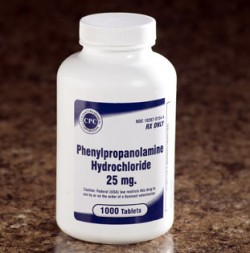
Phenylpropanolamine, also known as PPA, exists as one of many prescription amphetamine medications commonly used to treat conditions involving upper respiratory problems and obesity. As an amphetamine-based drug, phenylpropanolamine produces a stimulant effect within the body. Like most every stimulant-type medication, phenylpropanolamine works by speeding up a series of chemical processes throughout the body.
Phenylpropanolamine’s mechanism of action, while effective at alleviating certain symptoms, carries a lengthy side effect profile. In some cases, the potential for side effects can bring about serious health consequences to the point of life threatening symptoms. For these reasons, public health advisories surrounding phenylpropanolamine have resulted in pulling this drug off the market.
Uses
Phenylpropanolamine uses as a prescription drug and over-the-counter medication stem from its ability to alter certain chemical processes in the brain and central nervous system. As a prescription drug, phenylpropanolamine provides relief for cold and allergy symptoms brought on by congested airways. In effect, the drug works by shrinking blood vessels found in the nose, chest and sinuses. These effects help to reduce swelling along air passageways, which in turn allows mucus drainage to occur.
As an over-the-counter medication, phenylpropanolamine’s use as a treatment for obesity results from its ability to suppress activity within the part of the brain that regulates hunger or appetite. Weight loss products containing phenylpropanolamine also contain other appetite suppressant agents that work to enhance the overall effects of the drug.
Mechanism of Action

Phenylpropanolamine is a prescription drug used to treat the symptoms of congestion.
Phenylpropanolamine acts on specific cell receptor sites in the brain. These sites secrete various neurotransmitter chemicals, some of which include:
- Dopamine
- Norepinephrine
- Epinephrine
When ingested, phenylpropanolamine binds to cell receptor sites causing the release of large amounts of neurotransmitter chemicals. Normally, this particular group of chemicals works to regulate a person’s “fight or flight” response to stress.
Phenylpropanolamine’s effects are formulated to target the areas of the brain that regulate blood pressure levels and hunger responses. Other areas of the body affected by the drug’s effects include –
- Breathing rate
- Pupil responses
- Heart rate
- Cognitive functions
- Body temperature regulation
Side Effect Profile
The number of side effects associated with phenylpropanolamine use are many, some of which happen rarely but nonetheless carry serious health risks.
According to the University of Utah Health Care, common side effects from taking phenylpropanolamine include:
- Tremors
- Nausea/vomiting
- Problems sleeping
- Excess sweating
- Heart palpitations
- Painful urination
In some cases, more serious side effects can develop, some of which include:
- Breathing problems
- Severe headache
- Chest pains
- Loss of consciousness
- Convulsions
- Tingling in the extremities
- Numbness in the extremities
Public Health Advisory
As of the year 2000, the U. S. Food & Drug Administration (FDA) issued a public health advisory regarding the use of phenylpropanolamine drugs. The FDA reported unusually high incidents of stroke among 18 to 49 year olds brought on by the drug’s effects. Young women in particular were at considerable risk of developing stroke symptoms.
This public health advisory resulted in the discontinuation of phenylpropanolamine’s use as a weight loss remedy and required manufacturers to pull the product from store shelves. Since that time, phenylpropanolamine’s use as a prescription treatment has also been discontinued within the United States.


